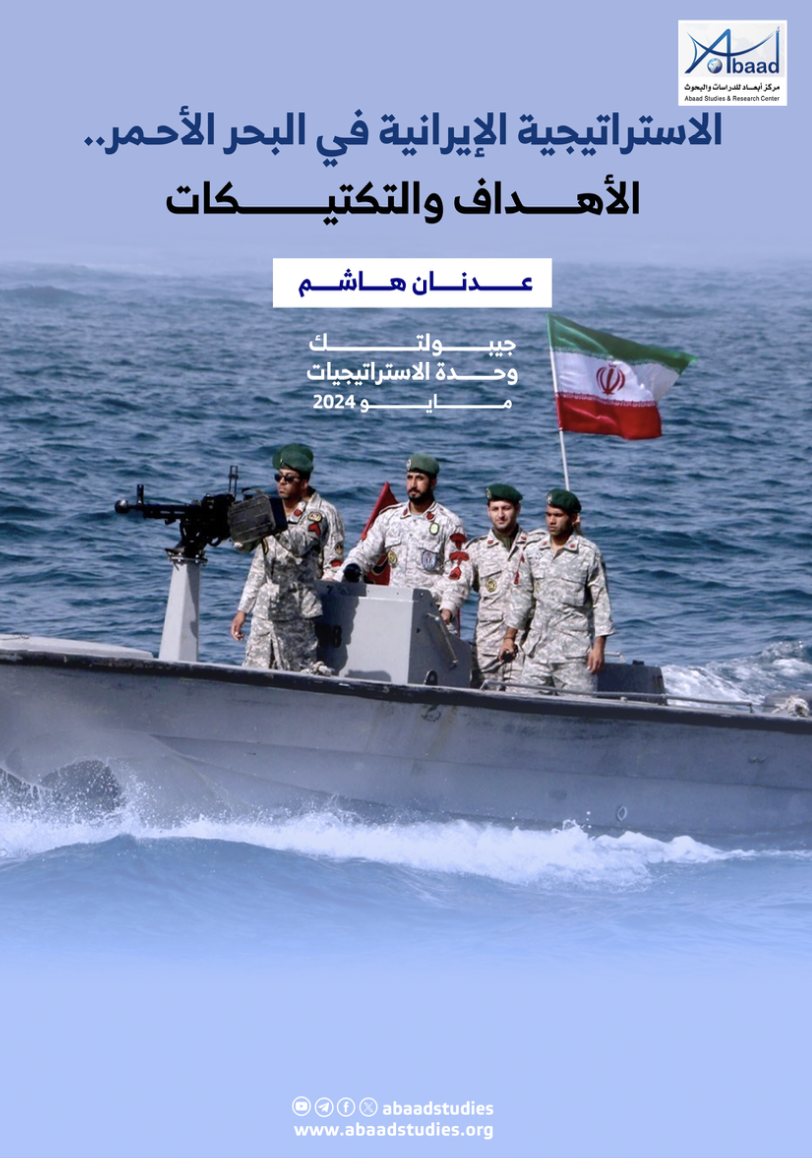الاستراتيجية الإيرانية في البحر الأحمر.. الأهداف والتكتيكات

مقدمة
يبدي صانع القرار الإيراني اهتماماً معلناً بوجود دائم في البحر الأحمر وخليج عدن منذ 07 أكتوبر/تشرين الأول الماضي عندما أعلن الاحتلال الإسرائيلي عمليته العسكرية في غزة، ردا على هجوم حماس.
ففي الشهر التالي شن الحوثيون هجمات على السفن التجارية والعسكرية في البحر الأحمر وخليج عدن والبحر العربي، ما جعل الولايات المتحدة والقوى الغربية تحشد سفنها الحربية إلى المنطقة التي تزداد اشتعالاً.
صرح اللواء يحيى رحيم صفوي – أحد كبار المستشارين العسكريين للمرشد الأعلى الإيراني – في 6 مارس/آذار أن القوات البحرية والجوية التابعة للحرس الثوري الإسلامي يجب أن "تركز" على البحر الأحمر والبحر الأبيض المتوسط.
ووصف صفوي البحرين بأنهما جزء من العمق الاستراتيجي لإيران، وأنه يجب على طهران وفقًا لذلك "زيادة عمقها الاستراتيجي [بمقدار] 5000 كيلومتر".
وقبل ذلك في ديسمبر/كانون الأول صرح قائد عسكري إيراني آخر أن حلفاءهم في محور المقاومة قادرون على وقف الملاحة في البحرين الأحمر والمتوسط.
يتزامن ذلك مع زيادة إيران لنشاطها في البحر الأحمر بإرسال سفن حربية، يَعتقد القادة العسكريون الغربيون أنها تستخدم لتقديم المعلومات الاستخباراتية للحوثيين لشن الهجمات البحرية.
وفي أبريل/نيسان أعلنت طهران أن سفنها الحربية سترافق السفن التجارية الإيرانية عبر البحر الأحمر؛ رغم الوجود الدولي الغربي المتزايد في المياه الدولية قبالة اليمن.
وبينما كانت الولايات المتحدة تدرس خططًا لتشكيل تحالف بحري ضد الحوثيين، قال وزير الدفاع الإيراني أمير أشتياني في ديسمبر/كانون الأول 2023 إن البحر الأحمر جزء من "منطقتنا" ولا يوجد به مكانا لقوات من خارج المنطقة. ومنذ2011 تنشر البحرية الإيرانية بانتظام سفن حربية في خليج عدن والبحر الأحمر. ومع مرور الأيام أصبح الوجود العسكري الإيراني في البحر الأحمر أكثر بروزا.
وفي يوليو/تموز 2022، أعربت وزارة الدفاع الإسرائيلية عن مخاوفها من أن الأصول البحرية الإيرانية في المنطقة شهدت الزيادة "الأكبر" خلال عقد من الزمن. وفي مارس/آذار أفادت وسائل إعلام أن المسؤولين في طهران طلبوا من الجيش السوداني قاعدة عسكرية دائمة على البحر الأحمر.
إن استراتيجية إيران لتوسيع نفوذها يتجاوز اليوم النشاط البحري للجمهورية الإسلامية، والذي أصبح من وجهة نظر الطاقة والجيو-سياسية له تأثير مباشر على التجارة بموارد الطاقة والتجارة العالمية والذي يسهل لها وجود ممر مهم مثل مضيق باب المندب.
فما هي استراتيجية إيران في البحر الأحمر؟!
أولاً: أهمية البحر الأحمر بالنسبة لإيران
منذ قيام الثورة الإيرانية 1979 لم يكن هناك نشاط بحري إيراني مؤكد في البحر الأحمر، على الرغم من الحديث أنها دعمت جماعة مسلحة لزرع ما يقرب من 200 لغم بحري في البحر الأحمر عام 1984م. لكن في مطلع 2011 أعلنت البحرية الإيرانية أنها ستدخل للمرة الأولى إلى البحر الأحمر بارسال سفن إلى سوريا. وبعد أشهر أعلنت أن غواصة تابعة للبحرية الإيرانية قطعت المياه الدولية عبر البحر الأحمر في دورية استمرت 68 يوماً بصناعة محلية.
مع ذلك فإن أهمية البحر الأحمر بالنسبة لإيران من العصور القديمة عندما بسطت الإمبراطورية الأخمينية نفوذها على طول شواطئه واستمرت من العصر الساساني إلى العصر العربي مع قيام الإسلام ودفع الخلافة الأموية للنفوذ الفارسي في شبه جزيرة العرب إلى خارج البحر الأحمر.[1]
وتأتي أهمية البحر الأحمر بالنسبة لإيران مع نفوذها المتعاظم في المنطقة خاصة في أفريقيا، حيث تستفيد إيران من اتساع الخلاف بين العديد من قادة ما بعد الانقلابات في منطقة الساحل والدول الغربية، بما في ذلك الولايات المتحدة وفرنسا. وفي يوليو/تموز 2023 زار الرئيس الإيراني إبراهيم رئيسي أوغندا وزيمبابوي وكينيا مشيداً بمقاومة هذه الدول للاستعمار "واعتبر ما تقوم به صحوة ويقظة"، أما الدول التي لم يزرها مالي وبوركينا فاسو والنيجر فقد أشاد في سبتمبر/أيلول2023 بمقاومتها هذه الدول"للسياسات الأوروبية المهيمنة والاستعمار".
الأهداف الإيرانية في البحر الأحمر
منذ 2012 بدا واضحاً أن إيران تسعى إلى توسيع وجود قواتها وأنشطتها البحرية إلى خارج الخليج العربي والمحيط الهندي، وتسعى لتحقيق هذه الأهداف في البحر الأحمر والبحر الأبيض المتوسط. وفي 2013 وحتى 2015 كانت طهران تركز على السودان وأرتيريا، وبدأ الحديث عن رغبة إيران بوجود قاعدة عسكرية خارج حدودها في ميناء بورسودان عام 2013م وارسلت عدداً من السفن في ذلك الوقت إلى الدولة الأفريقية التي كانت تعاني العزلة الغربية.
وتقلد طهران واشنطن في خلق ذرائع لوجود قواعد عسكرية في البحر الأحمر “إحباط الإرهاب والقرصنة"، وحماية "المشاعات البحرية العالمية" و"تأمين تجارتها البحرية".
ويوضح المسؤولون في البحرية الإيرانية منذ بدء انتشارها في 2011 سبب نشر السفن العسكرية في البحر الأحمر لتأمين الممر المائي ومواجهة القراصنة الصوماليين وتوسيع التواجد البحري لقواتها في المياه الدولية لحماية تجارتها.
وعلى الرغم من عتاقة السفن الحربية الإيرانية التقليدية إلا أنها استثمرت السنوات الأخيرة في بناء سفن سطحية قادرة على استضافة طائرات دون طيار هجومية سريعة ومروحيات وصواريخ. وهي التقنية والأسلحة التي يستخدمها الحوثيون في الهجمات البحرية الحالية، باعتبارهم الجهة غير الحكومية المدعومة من إيران. وتهدف بذلك إلى:
1-الضغط على الغرب:
في 14 مارس/آذار أعلن الحوثيون أن هجماتهم ستستهدف السفن التي تسافر إلى المحيط الهندي في طريقها إلى رأس الرجاء الصالح في جنوب أفريقيا. إذ أن 75% من السفن التجارية المسافرة بين آسيا وأوروبا أبحرت حول رأس الرجاء الصالح بدلا من المرور عبر مضيق باب المندب. وبعد عدة أيام من إعلان الحوثيين، أصدرت إيران، الداعم الرئيسي للجماعة، تحذيراً جديداً من جانبها، حيث صاغت التهديد كرد فعل على الإجراءات الأمريكية لفرض عقوباتها على قطاع الطاقة الإيراني. قال قائد البحرية في الحرس الثوري الإيراني، الأدميرال علي رضا تنكسيري، "إذا تم الاستيلاء على نفطنا وناقلاتنا في أي مكان في العالم، فسنرد بالمثل". وأضاف أن عصر “الاستغلال الأجنبي للموارد الإيرانية مع الإفلات من العقاب قد انتهى”.
-2استعراض القدرات واختبار مسرح الحرب:
يعتبر إطلاق الصواريخ الباليستية والأسلحة غير المأهولة التي يحصل عليها الحوثيون من إيران إظهاراً لقدرات الجمهورية الإسلامية العسكرية في أي ميدان معركة مستقبلية. وشارك الحوثيون في ابريل/نيسان في الانتقام الإيراني من "اسرائيل". ومن الممكن اعتبار إعلان إيران نشر سفن بحرية إيرانية إضافية في البحر الأحمر، على الحدود ليس فقط مع مصر أو المملكة العربية السعودية، بل وأيضاً في مناطق ذات أهمية حيوية لإسرائيل والأردن ؛ على أنه توسيع للمواجهة الإيرانية الإسرائيلية -المفترضة- ويخدم ما يراه الإيرانيون عصر أفول نظام القطب الواحد. وسبق أن استهدفت إسرائيل بالألغام اللاصقة سفينة "سافيز" عام 2021 والتي كانت تقدم المعلومات للحوثيين منذ 2015م.
ولم يخف الاستراتيجيون الإيرانيون رغبتهم في الوجود في البحر الأحمر وتوسيع نفوذهم إليه منذ نهاية العقد الأول من الألفية الجديدة ووسعت علاقتها مع السودان وارتيريا وجيبوتي لأغراض وصول القوات، وأرسلت سفناً حربية للمرة الأولى للبحر الأحمر إلى ميناء سوداني في أكتوبر/تشرين الأول2012، وأبدت رغبتها في الحصول على قاعدة عسكرية في البحر الأحمر.
-3 الاهتمام بأفريقيا:
تقدم الدول الأفريقية نفسها كفرصة لإيران لتصبح المزود الرئيسي للأسلحة للدول الأفريقية بدل من الأسلحة الغربية-التي عادة ما تكون مشروطة بعدم الانقلابات وانتهاكات حقوق الانسان-. توفر إيران طائراتها المسلحة بدون طيار لجماعات حرب العصابات في جميع أنحاء الشرق الأوسط منذ عقود، وقد أدى شراء روسيا لطائرات شاهد بدون طيار واستخدامها ضد أوكرانيا إلى زيادة الاهتمام الأفريقي وغيره بالأنظمة الإيرانية ومنذ مطلع العام تشير تقارير إلى أن إيران منحت الجيش السوداني طائرات مسيّرة لمواجهة قوات الدعم السريع.
و في مايو/أيار2023 زار وزير الدفاع المالي العقيد "ساديو كامارا" طهران وبحسب وسائل الإعلام الرسمية الإيرانية، فإن وزير الدفاع الإيراني محمد رضا أشتياني "أعرب عن استعداد بلاده لتزويد مالي بالمعدات العسكرية والخبرات في الحرب ضد الإرهاب".
يشير ذلك إلى جانب اهتمام إيران بنفوذها في غرب آسيا، وفي المنطقة القريبة منها –المنطقة العربية وآسيا الوسطى- فإنها مهتمة بشكل كبير بالوجود خارج هذه المنطقة ضمن تثبيت نفسها كقوة إقليمية أكبر ليس فقط في غرب آسيا بل وحتى في أفريقيا ما يتطلب منها وجوداً أكبر في البحر الأحمر.
ثانياً: التكتيكات والتحالفات
لا توجد قواعد عسكرية إيرانية دائمة في البحر الأحمر، ولجأت منذ بداية الألفية إلى الجانب الأفريقي للحصول على القاعدة، إما في ارتيريا –وهو أمر أكثر صعوبة مع وجود قاعدة عسكرية للإمارات وقاعدة أخرى لإسرائيل- حيث أشارت التقارير إلى وجود تلك القاعدة بين (2007-2015) في جزر دهلك. وفي مارس/آذار جددت طهران طلب الإذن من السودان بإنشاء قاعدة في بورسودان وهو ما تم رفضه.
وبناء على عقيدة الأمن القومي الإيراني القائمة على عمق استراتيجية يصل ل5000كم فإنها بحاجة إلى قاعدة عسكرية في البحر الأحمر وأخرى في البحر الأبيض المتوسط. وترى الاستراتيجية الإيرانية أن "وجود قواعد بحرية على مسافات بعيدة لا يقل أهمية عن الطاقة النووية بل هي أهم بعشر مرات لخلق الردع". وفي 2016 كشفت البحرية الإيرانية عن مساعيها لبناء قواعد بحرية في اليمن وسوريا.
وفي ظل حالة التهدئة الحذرة بين إيران والمملكة العربية السعودية منذ اتفاقية العاشر من مارس2023 التي رعتها الصين، فإن وجود إيراني معلن بقاعدة عسكرية في اليمن يبدو بعيد المنال لذلك ستسعى لمجموعة متنوعة من التكتيكات والتحالفات.
-1الحوثيون:
يعتبر الحوثيون الجماعة الوكيلة لإيران الوحيدة الموجودة على البحر الأحمر. تشير معلومات استخباراتية أمريكية حديثة إلى أن إيران كانت “مشاركة بعمق في تخطيط العمليات ضد السفن التجارية في البحر الأحمر”. ورسخت هجمات الحوثيين في البحر الأحمر الجماعة اليمنية في محور المقاومة التابع لإيران بعد أن تخوف الحوثيون من أي تداعيات لإتفاق العاشر من مارس2023 بين السعودية وإيران.
إن الأزمة التي نجمت عن هجمات الحوثيين في البحر الأحمر أثبتت أنها منيعة أمام المبادرات الدبلوماسية الدولية والضربات والتهديدات العسكرية الأمريكية. وتظهر قدرة جهة فاعلة غير حكومية تابعة لإيران على ممارسة تأثير كبير على الاقتصادات المتقدمة عالمياً والتي تعتمد 70% منها على حرية الملاحة. وهو أمر حيوي بالنسبة لطموح إيران بالتأثير في السياسات العالمية.
إن فشل استراتيجيات أكثر الجيوش تطوراً في العالم في وقف هجمات الحوثيين البحرية خلال الأشهر الماضية، هو انتكاسة للولايات المتحدة وبريطانيا. واستعراضاً للدعاية الإيرانية بتفوق قدراتها العسكرية لحلفائها والدول التي تبحث عن تكنولوجيا الأسلحة الأكثر تأثيراً على الجيوش النظامية.
2- محور أفريقيا:
لا تخفي إيران اهتمامها بأفريقيا ومنذ سنوات عمدت استراتيجتها على الوصول إلى هذه البقعة الاستراتيجية والاقتصادية الهامة. فعدد السكان الذي يبلغ 200 مليون نسمة، مما يجعلها سوقًا كبيرًا للمنتجات الإيرانية التي تعاني بسبب العقوبات الأمريكية. وتسمح السياسات المتداخلة بنفوذ إيراني في تلك الجغرافيا كجزء من منافستها مع خصومها التقليديين على مستوى الإقليم. في مارس/آذار2023 زار ابراهيم رئيسي الرئيس الإيراني دول شرق أفريقيا ووقع اتفاقيات مع ثلاثة من البلدان كينيا وأوغندا وزيمبابوي. وفي مطلع العام الحالي اتخذ قادة ما بعد الانقلاب (مالي، وبوركينا فاسو، والنيجر) خطوات ملموسة لإبعاد بلدانهم عن القوة الاستعمارية فرنسا والولايات المتحدة، مكررين اتهامات طهران بأن القوى الغربية تستغل السكان الأفارقة وغيرهم من سكان جنوب العالم لتحقيق مصالحهم الذاتية.
ويرى القادة الإيرانيون أن توسيع العلاقات مع زعماء أفريقيا يمكن أن يساعد إيران على التحايل على العقوبات التي تقودها الولايات المتحدة وتعزيز دور إيران كمورد للأسلحة المتطورة، وخاصة الطائرات بدون طيار، وهو ما حدث بتوقيع اتفاقات عسكرية واقتصادية. كما اتخذت طهران جانباً من الصراع في السودان وزودت الجيش بطائرات مسيّرة لمواجهة قوات الدعم السريع المدعومة من دولة الإمارات.
تشكل هذه التحالفات المرتبطة بأفريقيا علاقة وثيقة بالبحر الأحمر وحرية الملاحة فيه للتجارة والقوات البحرية الإيرانية التي تحمي مصالحها، وجزء من الاستراتيجية الإيرانية كقوة إقليمية وعالمية مؤثرة.
-3التنسيق بين أعضاء محور المقاومة:
من الخليج العربي إلى البحر المتوسط تحتاج طهران إلى مراكز ونقاط تمر عبر ما تعتبره "عمقاً استراتيجياً" يوفر حلفاء ووكلاء إيران في المنطقة العربية ذلك النفوذ. وخلال العقد الماضي تضرر هؤلاء الوكلاء بما في ذلك القيود المتزايدة على لبنان كمركز إقليمي للثورة الإيرانية ومحور المقاومة، لذلك تشكل هجمات الحوثيين في البحر الأحمر إعادة انتاج مركز إقليمي جديد لإيران في المنطقة، ومرحلة جديدة من مراحل تصدير الثورة ودعم سياسات إيران في الخليج العربي وشرق أفريقيا. وتشير المعلومات إلى أن صنعاء قد تكون بديلاً عن بيروت والدوحة لحركات المقاومة الفلسطينية المرتبطة بإيران، إلى جانب المعارضين الشيعة في دول مجلس التعاون الخليجي. ما يعني تأثير أكبر للتحالفات الإيرانية على الأمن البحري حول مضيق باب المندب.
-4القوة البحرية الكلاسيكية والتنظيمات التعبوية والشعبية:
مقارنة بالقوى الغربية فإن القوى البحرية الإيرانية الكلاسيكية ضعيفة، لكنها قادرة على المناورة والتحرك في المياه الدولية وتحتاج إلى قواعد بحرية.
في منطقة من التجاذبات والنفوذ والتحديات المتعلقة بالسيادة والمخاوف من القوى الاستعمارية، تحتاج إيران للتحالف مع تنظيمات تعبوية وشعبية خاصة في دول شرق وساحل أفريقيا. وهو الذي بات واضحاً في النيجر حيث تنتشر عمليات التشيع والمعاهد التعبوية الإيرانية.
ثالثاً: تأثير الاستراتيجية الإيرانية في البحر الأحمر
تواجه المنطقة بالفعل تهديدات أمنية واقتصادية مع الصراع الإقليمي والدولي على الهيمنة، وتبدو إيران في قلب هذه الهيمنة مستخدمة تكتيكاتها التي تعتمد على الجهات غير الحكومية في التأثير، وعلى سياسة خارجية بعيدة عن الغرب الاستعماري. مستخدمة إخفاقات السياسة الخارجية الغربية لتحقيق مكاسبها.
ومنذ أكثر من عقد تعاني المنطقة من تهديدات أمنية: هجمات الحوثيين البحرية، الحروب الأهلية، والقرصنة البحرية، والتوترات الإقليمية على ضفتي البحر الأحمر، التطرف والإرهاب. كما أن التحديات الاقتصادية التي تواجه المنطقة متعددة من تحوّل دول الخليج إلى مرحلة ما بعد النفط، إلى التحوّل والتكامل الاقتصادي في بلدان شرق أفريقيا.
إن الاستراتيجية الإيرانية الحالية ستكون مصدراً لتهديدات أمنية وسياسية على المدى القصير والمدى المتوسط، وتزيدها التوترات الإقليمية وقد ينقل المنطقة في وقت سريع من منطقة أمن بحري مرتبطة بالمنطقة إلى "أمن بحري دولي" خاصة مع الوجود المتزايد للبحرية الدولية في المنطقة.
-1التهديد الأمني:
يخاطر النفوذ الإيراني بالمزيد من الحروب الأهلية الداخلية، وهو شأن معظم دول الإقليم التي تدعم أطرافاً محلية على حساب أخرى من أجل النفوذ. واتخذت الإمارات وإيران موقفان مختلفان من الحرب الأهلية السودانية. كما يمكن أن يجزأ أمن المنطقة من اتخاذ أطراف تهدد أمن البحر الأحمر مثل اتفاقية الوصول الأثيوبية إلى مضيق باب المندب وخليج عدن عبر اتفاقية أرض الصومال المدعومة من الإمارات، وهو ما دفع الحكومة المركزية في مقديشو إلى توقيع اتفاقية عسكرية مع تركيا المنافس الآخر لإيران.
إن تزايد التنافس بين الدول الإقليمية والدولية على النفوذ في البحر الأحمر، يخلق أخطار تهيئ لنشوب صراعات إقليمية متعددة، ويزيد من عمل القرصنة التي تستغل حالة التوترات لعودة هجماتها على السفن التجارية؛ ومع انهيار الدول القومية وحالة عدم الاستقرار الداخلية يزيد وجود التطرف والإرهاب العابر للحدود.
من الناحية الدولية يبدو استخدام إيران للحوثيين في البحر الأحمر في عمليات غير مكلفة من القوة الصارمة لإثارة قلق واشنطن وحلفائها في الناتو، في حين يستحوذون على إعجاب أولئك في العالم النامي الذين يشعرون بالفزع من السلوك الإسرائيلي في غزة. وهو ما سيدعم النفوذ الإيراني هناك للتمدد في محلّ الصراع الجديد في السياسة الدولية الجديدة خاصة في الشرق الأوسط وأفريقيا.
2-التأثير على الاقتصاد الدولي:
تستخدم إيران الهجمات في البحر الأحمر عبر الحوثيين كأداة عقوبات اقتصادية على الولايات المتحدة والاتحاد الأوروبي، رداً على العقوبات الأمريكية والأوروبية عليها. ولا يبدو أن السفن الصينية والروسية تعاني من ذات الهجمات الحوثية.
نجح الحوثيون ومن خلفهم إيران في تحقيق هدفهم في فرض تكاليف على السياسات الغربية الداعمة للاحتلال الإسرائيلي، على الرغم من أن الحملة ضد السفن لم يكن لها تأثير ملحوظ على الهجوم الإسرائيلي في قطاع غزة، إلا أن استعراض القوة قرب مضيق باب المندب أثر على الأسعار في الاتحاد الأوروبي وعلى الطاقة والتجارة البحرية.
عزز قادة الحوثيين المزايا التنافسية لشركات الشحن الصينية والروسية من خلال توفير ممر آمن للبحر الأحمر مع ضمانات ضد الهجوم مقابل دعم دبلوماسي لم يتم تحديده بعد.
تتمثل الإستراتيجية الانتقائية التي يستخدمها الحوثيون في فرض عقوبات اقتصادية تشبه العقوبات الاقتصادية التي تؤثر بشكل غير متناسب على الشركات التي يوجد مقرها في الاتحاد الأوروبي وكذلك على مصر، التي تخسر رسوم عبور قناة السويس بسبب تحويلات الشحن حول الطرف الجنوبي من أفريقيا.
خاتمة.. هل يمكن ردع الاستراتيجية الإيرانية؟
على الرغم من مكاسب روسيا والصين الحالية من الاستراتيجية الإيرانية الحالية في البحر الأحمر إلا أن ذلك لن يستمر طويلاً، إذ أن الدولتين ستشعران بالمتغيرات التي تفرضها إيران على اقتصادهما على المدى المتوسط. لكن التعامل الغربي مع الأزمة الحالية في الممر المائي الحيوي في باب المندب وخليج عدن سلوك من العنجهية الغربية الذي يخدم الدعاية الإيرانية في العالم النامي ودول المنطقة؛ ويثير مخاوف الاستعمار من جديد لهذه البلدان ما يدفعها نحو الشرق وهو ما يُعقد دينامكيات الأمن البحري في البحر الأحمر.
يمكن ردع الاستراتيجية الإيرانية في البحر الأحمر في استراتيجية مضادة ناشئة من الدول المشاطئة على البحر الأحمر مع دعم دولي من خارجها والذي يشمل أيضاً الصين وروسيا إذ أن الدولتين تتمتعان بعلاقة جيدة في الوقت الحالي مع معظم الدول المشاطئة.
إن وجود استراتيجية من خارج المنطقة للتعامل مع الأمن البحري للبحر الأحمر وخليج عدن يصب الزيت على النار ويشعل التنافس الدولي في منطقة تعاني اضطراباً وعدم استقرار منذ عقود.
وحتى تجدّ دول المنطقة سبيلها إلى استراتيجية جديدة لحماية الأمن البحري في منطقة البحر الأحمر مع مشاركة محدودة من الدول الفرعية المرتبطة بأمن البحر الأحمر والذي يشمل الإمارات وإيران واثيوبيا، فإن التطورات الحالية لا تخدم إلا صناع السياسات الموجودين في طهران.

[1] Bowersock, G.W. The Throne of Adulis: Red Sea Wars on the Eve of Islam. Oxford University Press, 2013






